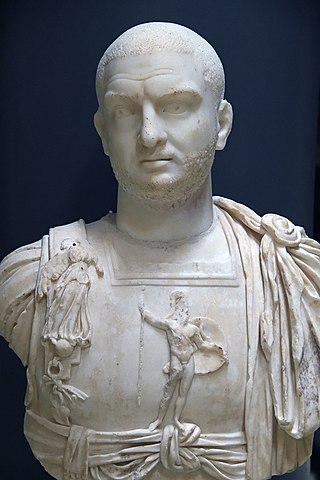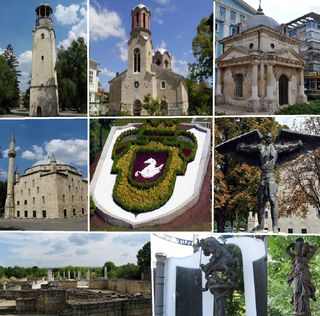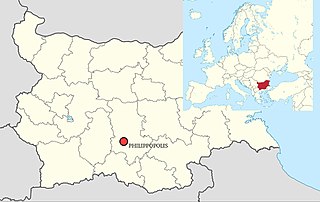
Year 251 (CCLI) was a common year starting on Wednesday of the Julian calendar. At the time, it was known as the Year of the Consulship of Traianus and Etruscus. The denomination 251 for this year has been used since the early medieval period, when the Anno Domini calendar era became the prevalent method in Europe for naming years.
The 250s was a decade that ran from January 1, 250, to December 31, 259.
The Battle of Naissus was the defeat of a Gothic coalition by the Roman Empire under Emperor Gallienus and the future Emperor Aurelian near Naissus. The events around the invasion and the battle are an important part of the history of the Crisis of the Third Century.

Gaius Messius Quintus Trajanus Decius, known as Trajan Decius or simply Decius, was Roman emperor from 249 to 251.

Gaius Vibius Trebonianus Gallus was Roman emperor from June 251 to August 253, in a joint rule with his son Volusianus.

Marcus Aemilius Aemilianus, also known as Aemilian, was Roman emperor for three months in 253.

Quintus Herennius Etruscus Messius Decius, known simply as Herennius Etruscus, was briefly Roman emperor in 251, ruling jointly under his father Decius. His father was proclaimed emperor by his troops in September 249 while in Pannonia and Moesia, in opposition to Philip. Decius defeated Philip in battle, and was then proclaimed emperor by the Senate. Etruscus, still a child, was elevated to Caesar (heir) in 250, then further raised to Augustus (emperor) in May 251. When the Goths, under Cniva, invaded the Danubian provinces, he was sent with a vanguard, followed by the main body of Roman troops, led by Decius. They ambushed Cniva at the Battle of Nicopolis ad Istrum in 250, routing him, before being ambushed and routed themselves at the Battle of Beroe. Etruscus was killed in the Battle of Abritus the following year, alongside his father. After the deaths of both emperors, Trebonianus Gallus, who had been governor of Moesia, was elected emperor by the remaining Roman forces.

Hostilian was briefly Roman emperor in 251. Hostilian was born to Decius and Herennia Etruscilla at an unknown date and elevated to caesar in 250 by Decius. After Decius and Herennius Etruscus, Hostilian's brother, were killed at the Battle of Abritus, an ambush by the Goths, Trebonianus Gallus was proclaimed emperor by the legions. Almost immediately, he elevated Hostilian to co-emperor and his own son, Volusianus, to caesar. Hostilian died soon after, either due to plague or being murdered by Trebonianus Gallus.

Cniva was a Gothic king who invaded the Roman Empire. He successfully captured the city of Philippopolis in 250 and killed Emperor Decius and his son Herennius Etruscus at the Battle of Abritus as he was attempting to leave the Empire in 251. This was the first time a Roman Emperor had been killed in combat against foreigners. He was allowed by the new Emperor Trebonianus Gallus to leave with his spoils and was paid tribute to stay out of the empire.

Gaius Vibius Volusianus, commonly called Volusian, was a Roman emperor from 251 to 253, ruling with his father Trebonianus Gallus.

The Carpi or Carpiani were a Dacian tribe that resided in the eastern parts of modern Romania in the historical region of Moldavia from no later than c. AD 140 and until at least AD 318.

Razgrad is a city in Northeastern Bulgaria in the valley of the Beli Lom river that falls within the historical and geographical region of Ludogorie (Deliorman). It is an administrative center of Razgrad Province.
The Gothic wars or Roman–Gothic wars were a long series of conflicts between the Goths and the Roman Empire between the years 249 and 554 AD. The main wars are detailed below.

The siege of Philippopolis was fought in about 250 between Rome and the Goths during the invasions of 249–253 at the Thracian city of Philippopolis, modern Plovdiv, Bulgaria. It was part of the long-running series of Gothic Wars.

Abritus (Abrittus) was an impressive Roman walled city and one of the biggest urban centres in the province of Moesia Inferior. Its remains are in the Archaeological Park of Razgrad.
The Battle of Verona was fought between the Roman general and usurper Decius, and emperor Philip the Arab in 249. Decius was victorious and Philip and his son Philip II were both killed. Decius was subsequently declared Roman emperor.

The Battle of Nicopolis ad Istrum was fought between the Roman army of Emperor Decius and his son Herennius Etruscus, and the Gothic army of King Cniva, in 250 AD. The Romans were victorious.
Ostrogotha was a leader of the eastern Goths in the Ukraine, who invaded Roman Moesia during the Crisis of the Third Century, mentioned by the 6th-century historian Jordanes. He was a contemporary of King Cniva.

The Gothic War took place between the years 248 and 249, as well as in the year 253. Within this war, a series of battles occurred and plundering was carried out by the Goths and their allies in the eastern territory of the Roman Empire, specifically in the Balkans. With the cessation of the payment of tribute previously made by the Roman emperor Philip the Arab to the tribes beyond the Danube, the Goths and their allies, led by King Ostrogotha and his subcommanders Argedo and Gundericus, moved towards the Roman border and began a series of attacks, including against the fortified city of Marcianopolis in Thracia. After these actions, the Goths withdrew with their spoils of war.

The barbarian invasions of the third century (212-305) constituted an uninterrupted period of raids within the borders of the Roman Empire, conducted for purposes of plunder and booty by armed peoples belonging to populations gravitating along the northern frontiers: Picts, Caledonians, and Saxons in Britain; the Germanic tribes of Frisii, Saxons, Franks, Alemanni, Burgundians, Marcomanni, Quadi, Lugii, Vandals, Juthungi, Gepids and Goths, the Dacian tribes of the Carpi and the Sarmatian tribes of Iazyges, Roxolani and Alans, as well as Bastarnae, Scythians, Borani and Heruli along the Rhine-Danube rivers and the Black Sea.
















